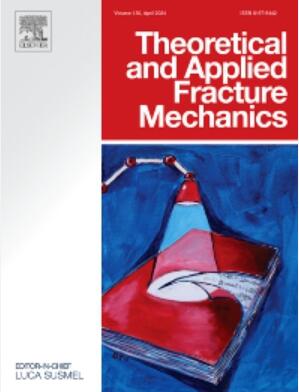远程剪切加载下脆性多层板中心裂缝的弱界面诱导重复扭结
IF 5
2区 工程技术
Q1 ENGINEERING, MECHANICAL
引用次数: 0
摘要
要控制多层复合材料复杂的断裂轨迹,了解裂纹的重复扭结模式至关重要。虽然之前的研究已经探索了层状材料断裂的许多方面,但基本加载模式下的重复扭结行为的支配条件在很大程度上仍未被揭示。本研究阐明了在远程剪切应力作用下,具有紧密平行弱界面的脆性多层板中中心裂缝的持续扭结条件。利用应变能释放率(SERR)准则,我们通过等效裂缝概念分析得出了该条件的闭式解。该解为弱界面的交角和断裂韧性比指定了一个值域,在该值域中,载荷引导方向与弱界面引导方向紧密竞争,将裂纹轨迹塑造成重复的扭结模式。我们的理论结果得到了一系列有限元(FE)模拟的验证,阐明了在远程剪切荷载作用下,紧密平行的弱界面是如何在多层材料中诱发重复裂纹扭结的。这项研究为深入理解各种实际应用中混合载荷下错综复杂的裂纹轨迹铺平了道路。本文章由计算机程序翻译,如有差异,请以英文原文为准。
Weak interface-induced repeated kinking of a central crack in a brittle multilayered plate under remote shear loading
Understanding the repeated kinking pattern of cracks is essential for controlling the complex fracture trajectories in multilayered composites. While previous studies have explored many aspects of fractures in layered materials, the conditions governing the repeated kinking behavior under basic loading modes remain largely unrevealed. This research elucidates the continual kinking condition for a central crack in a brittle, multilayered plate with closely-parallel weak interfaces under remote shear stresses. Using the strain energy release rate (SERR) ratio criterion, we analytically derived a closed-form solution to the condition through the equivalent crack concept. The solution specifies a value domain for the intersection angle and fracture toughness ratio of weak interfaces, where the load-guided direction competes closely with the weak interface-guided direction to shape the crack trajectory into a repeated kinking pattern. Our theoretical results, validated by a series of finite element (FE) simulations, clarify how closely-parallel weak interfaces induce repeated crack kinking in multilayered materials under remote shear loading. This research paves the way for the deeper understanding of intricate crack trajectories under mixed loads in various practical applications.
求助全文
通过发布文献求助,成功后即可免费获取论文全文。
去求助
来源期刊

Theoretical and Applied Fracture Mechanics
工程技术-工程:机械
CiteScore
8.40
自引率
18.90%
发文量
435
审稿时长
37 days
期刊介绍:
Theoretical and Applied Fracture Mechanics'' aims & scopes have been re-designed to cover both the theoretical, applied, and numerical aspects associated with those cracking related phenomena taking place, at a micro-, meso-, and macroscopic level, in materials/components/structures of any kind.
The journal aims to cover the cracking/mechanical behaviour of materials/components/structures in those situations involving both time-independent and time-dependent system of external forces/moments (such as, for instance, quasi-static, impulsive, impact, blasting, creep, contact, and fatigue loading). Since, under the above circumstances, the mechanical behaviour of cracked materials/components/structures is also affected by the environmental conditions, the journal would consider also those theoretical/experimental research works investigating the effect of external variables such as, for instance, the effect of corrosive environments as well as of high/low-temperature.
 求助内容:
求助内容: 应助结果提醒方式:
应助结果提醒方式:


